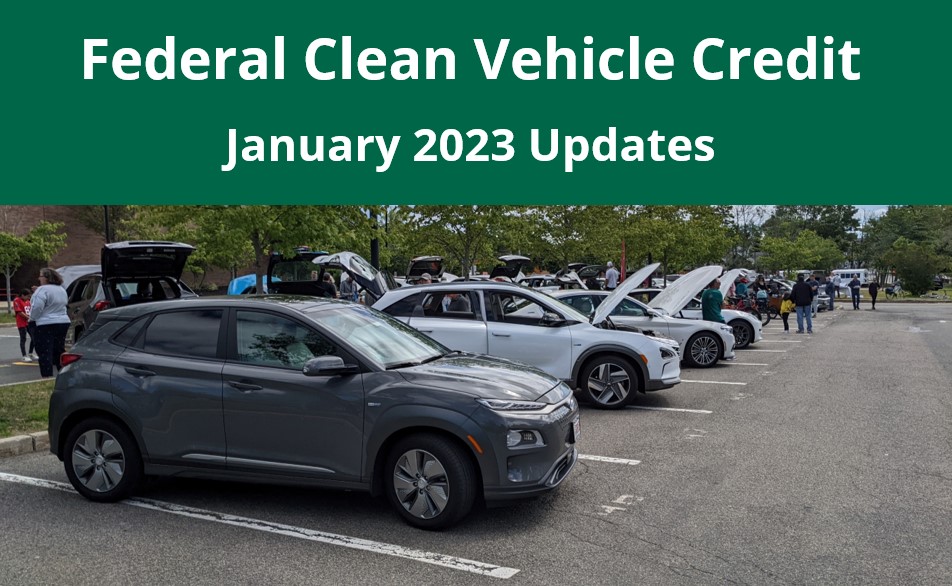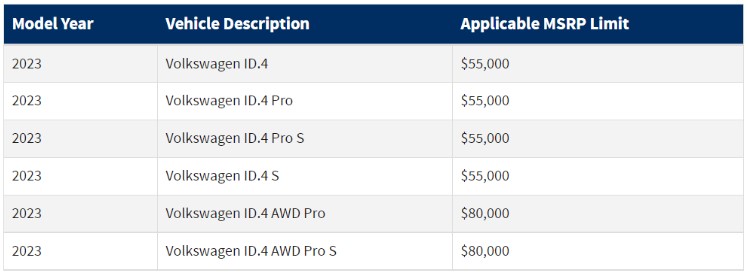New List of Electric Cars for Federal Tax Credit
Earlier this month, we published a blog warning that the list of electric vehicles (EVs) that qualify for the...

At the end of 2022, we wrote about the new federal tax credit for electric vehicles (EVs) and the delay of the implementation of the battery requirements written into the Inflation Reduction Act (IRA). Now that it’s officially 2023 and the US Department of Treasury and Internal Revenue Service (IRS) have released some more information about the credit, here’s what you need to know.
Please note: this blogpost reports on what we know as of today, but this is a developing story. We will always update the latest on our Rebates & Incentives page, so head there if you're reading this after January 2023!
Many of the key provisions in the IRA have now taken effect. The manufacturers’ cap has been lifted, which means Tesla, General Motors, and Toyota vehicles are newly eligible for the federal tax credit. In order to qualify for the Clean Vehicle Credit in 2023, your income must be below certain thresholds: $150,000 for single filers and $300,000 for joint filers. The vehicle itself must be under a certain Manufacturers’ Suggested Retail Price (MSRP) ($80,000 for SUVs, vans, and pickup trucks; $55,000 for sedans and everything else) and the vehicle’s final assembly location must be in North America. Finally, used cars now qualify for a federal tax credit for the first time (details and qualifications here).
However, as we reported just before the end of the year, the Treasury and IRS recently announced that the battery requirements in the IRA will be delayed until at least March 2023. (Note: Battery requirements to not apply to used cars.) Further guidance released recently gives us a better idea of what qualifies for what.
 The Hyundai Ioniq 5: An excellent all-electric vehicle that is assembled outside of North America and therefore does not qualify for the new Clean Vehicle Credit as of January 1, 2023.
The Hyundai Ioniq 5: An excellent all-electric vehicle that is assembled outside of North America and therefore does not qualify for the new Clean Vehicle Credit as of January 1, 2023.
The IRS recently published a webpage entitled Manufacturers and Models for New Qualified Clean Vehicles Purchased in 2023 or After. (There’s an equivalent page for qualified used EVs here.) This page lists the requirements of the new Clean Vehicle Credit and then shares a list of manufacturers and models with the MSRP limit that applies to each model. This list is crucial, because it determines which vehicles are deemed by the IRS to be SUVs ($80,000 price limit) and which are considered sedans or hatchbacks ($55,000 price limit). For example, if you look at Volkswagen’s vehicles, you’ll see that different versions of the ID.4 have different MSRP limits:

This page helps us weed out which vehicles meet the MSRP requirement, and which don’t. However, there’s one big caveat with this page: just because an EV model is listed on this page does NOT mean it qualifies for a federal tax credit because it must also meet the other requirements of the IRA, notably the final assembly location requirement. To figure out which vehicles meet that requirement, you have to cross-reference the list from the IRS with this resource from the Department of Energy. (Don’t worry – we've done this work for you. More on that below.) By comparing those two resources, we know which vehicles qualify. But for how much?
The way the IRA is written, it’s supposed to be the battery requirements that determine the amount of the tax credit an EV model qualifies for. However, since the implementation of those requirements is now delayed, the Treasury and IRS have announced that the battery size of the vehicle will determine the credit amount in the interim. If you want to learn the formula (the same one that has been used through the end of 2022), check out Q6 on this IRS FAQ page. But if you don’t want to do the math, we’ve updated the amounts on our Drive Green shopping portal for you!
Another big caveat: The listed amounts are just in effect until the Treasury and IRS release the battery guidance, which they “anticipate issuing... in March” according to that same FAQ page. At that point, the amount for each model will be determined by compliance with the battery requirements (which are explained in more detail here) instead of battery size.
So, in sum: there will be one set of federal tax credit amounts from now until the battery guidance kicks in, another set of credit amounts afterwards, and we don't know when exactly that transition will take place.
The FAQs and other guidance released by the IRS include other important details, notably:
If you’d like to go straight to the source, the IRS has published an extensive list of FAQs that we encourage you to peruse, either in this PDF fact sheet or right on the IRS website (see the list of related content on the right side of that webpage).
The full implementation of the new Clean Vehicle Credit will unfortunately continue to be confusing. For one thing, many manufacturers still haven’t completed the paperwork needed to be considered “qualified manufacturers.” On the list maintained by the IRS, there are several notable manufacturers that haven't yet been approved: Hyundai, Kia, Mitsubishi, Subaru, and Toyota. The IRS webpage will be updated over time, and hopefully we’ll get clarity on those manufacturers soon. We will keep checking it and updating our Drive Green shopping portal as more information is released.
Then there’s the question of when the battery requirements will actually take effect. The Treasury and IRS maintain that they anticipate releasing full guidance in March 2023. When they do, they will likely solicit stakeholder input before issuing final regulations. And only then will manufacturers start submitting the paperwork to verify that their vehicles meet the requirements. And even then, more changes will likely be coming; in this whitepaper, the Treasury indicates that they may propose a three-step transition period for manufacturers that will last through 2023 into 2024. Exactly what this will look like, we don’t yet know. So, while March is the next stop on this journey, it’s certainly not the last. Buckle up!
If you’re in the market for an electric vehicle right now, here’s what we would recommend.
We hope this blogpost has cleared up some confusion in a very perplexing time. If you have questions, please don’t hesitate to reach out to us at drivegreen@greenenergyconsumers.org. We will do our best to help! And again – as more details come out, we will keep you posted on this blog!
Earlier this month, we published a blog warning that the list of electric vehicles (EVs) that qualify for the...
Last week, the Internal Revenue Service (IRS) and Treasury Department made a change to the federal tax credit for...
Comments